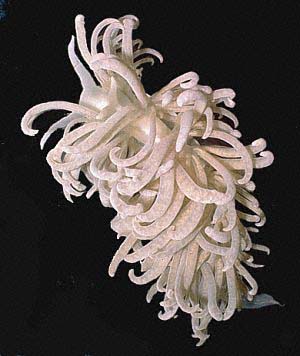
Phyllodesmium hyalinum
Ehrenbergh, 1831
Order: NUDIBRANCHIA
Suborder: AEOLIDINA
Family: Glaucidae
DISTRIBUTION
Originally described from the Red Sea, it has been reported from Tanzania, Japan and the Philippines. It also occurs on the Great Barrier Reef in eastern Australia.
PHOTO
Bongoyo Is, off Dar es Salaam, Tanzania, November 1976. 45mm long. PHOTO: Bill Rudman.
RELATED TOPIC
Phyllodesmium hyalinum feeds on the soft coral Xenia. It is very difficult to find because it burrows into the fleshy 'trunk' of the colony only emerging to feed. It is very similar in appearance to Phyllodesmium crypticum which also feeds on Xenia. Both animals rapidly drop off many of their cerata when disturbed.
Here are some distinguishing characters between the two species:
The cerata of P. crypticum are very nodulose, especially along the edges, whereas in P. hyalinum the cerata are basically smooth. In both species, the cerata are arranged in arches, but in P. hyalinum they are much more numerous and arranged in double rows. An important difference is the position of the anal papilla. In P. hyalinum it is situated above and slightly behind the second ceratal arch on the right side, while in P. crypticum it is inside the second arch which consists of a single row of cerata. The radular teeth are similarly shaped in both species but in P. hyalinum the denticles are approximately twice as numerous. The anterior foot corners in P. crypticum are developed into tentacular processes while in P. hyalinum they form only slightly rounded extensions.
Rudman, W.B., 1998 (October 15) Phyllodesmium hyalinum Ehrenbergh, 1831. [In] Sea Slug Forum. Australian Museum, Sydney. Available from http://www.seaslugforum.net/find/phylhyal
Related messages
Phyllodesmium hyalinum from the Red Sea
March 3, 2005
From: Oren Lederman
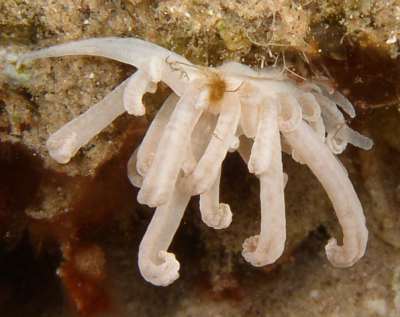
Hi Bill,
We think this one is a mature Phyllodesmium sp.8. A few months ago I sent you a photo of a small one.
Locality: "Dekel" beach, Eilat Bay (Night dive). Israel, Red Sea. Depth: ~3 meters. Length: ~5 cm. 17 Feb 2005. Photographer: Oren Lederman
Oren Lederman
lederman@bigmail.co.il

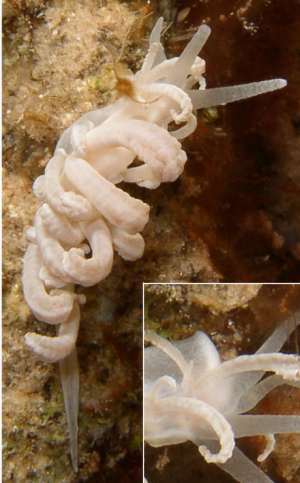
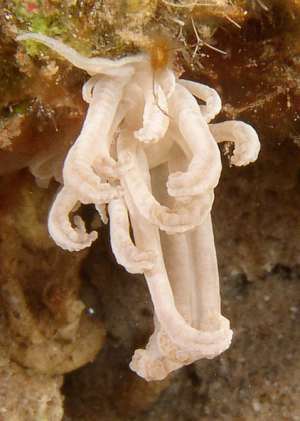
Dear Oren,
I am pretty sure this Phyllodesmium hyalinum, which was described from the Red Sea in 1831. It feeds on the soft coral Xenia and is usually very difficult to find because it burrows into the fleshy 'trunk' of the colony only emerging to feed. In the photo on the left a bit of a Xenia colony can be seen at the top of the photo. It is very similar in appearance to Phyllodesmium crypticum which also feeds on Xenia. Both animals rapidly drop off many of their cerata when disturbed [see autotomy Fact Sheet], and I suspect your animal has lost quite a few of its cerata..
In the photo on the left above, I have ringed the anal papilla. In P. hyalinum it is situated above and slightly behind the second ceratal arch on the right side, while in P. crypticum it is inside the second arch. It is not clear in your photo because many of the cerata are missing, but it is certainly higher than I have seen in P. crypticum. Another difference is that the anterior foot corners in P. crypticum are developed into tentacular processes while in P. hyalinum they form only slightly rounded extensions. In the lower right photo above I have included an inset showing the front of the foot, which looks much more like P. hyalinum than P. crypticum, so my best guess is that this is P. hyalinum.
Best wishes,
Bill Rudman
Phyllodesmium hyalinum from Red Sea
May 19, 2003
From: Alon Braun
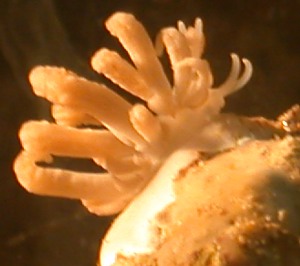
Hello,
Can you please help me with this one?
We found him on a colony of Heteroxenia at Eilat, Israel, in the Gulf of Aqaba.
Alon Braun
alonbr@pob.huji.ac.il
Braun, A., 2003 (May 19) Phyllodesmium hyalinum from Red Sea. [Message in] Sea Slug Forum. Australian Museum, Sydney. Available from http://www.seaslugforum.net/find/9962Dear Alon,
This is Phyllodesmium hyalinum, which feeds on xeniid coft corals, often burrowing into the basal part, so that it is seldom seen. It was in fact first described from the Red Sea by Ehrenbergh (1831) in a report on one of the first biological expeditions out of Europe in the early 19th century.
Best wishes,
Bill Rudman
Phyllodesmium from Japan
January 18, 2001
From: Satoru Hori

Dear Bill
My friend, Matsuura, found this sea slug in Yokosuka, Japan. He took it in his fish tank. After a few weeks, he noticed this sea slug ate soft coral in his tank. Before he returned it to the sea, I took this photo.
Its length is about 15mm. Rhinophores are smooth. Ceratas are not smooth. Some ceratas are located just at the side of the rhinophores.
Could you identify it for me?
Thank you.
Satoru Hori
ik8s-hr@asahi-net.or.jp
Hori, S. , 2001 (Jan 18) Phyllodesmium from Japan. [Message in] Sea Slug Forum. Australian Museum, Sydney. Available from http://www.seaslugforum.net/find/3559Dear Satoru,
Thanks for the photo. This is a species of Phyllodesmium, and most probably it is Phyllodesmium hyalinum which feeds on soft corals such as Xenia. P. hyalinum and a another similar species Phyllodesmium crypticum have bumps on the cerata as in Matsuura's photo. The cerata therefore look very like the tentacles of the Xenia polyp so that it is very difficult to find when it is feeding. Have a look at the photo of Xenia and its tentacles elsewhere in the Forum.
Best wishes,
Bill Rudman
Phyllodesmium hyalinum from South Africa
April 22, 2000
From: Valda Fraser
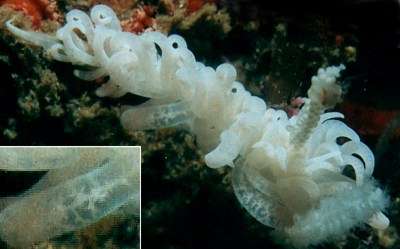
Dear Bill
I know that Phyllodesmium magnum looks like this, but the size is wrong? This nudibranch is much smaller. I hope you will have some ideas. Also, I would like you to comment on the colour variation. Thanks.
Locality: South coast KwaZulu-Natal SOUTH AFRICA near Port Shepstone - 18m
Date: April 1999
Size: UPPER: 35mm
LOWER: 26mm
Regards
Valda Fraser
iti04937@mweb.co.za
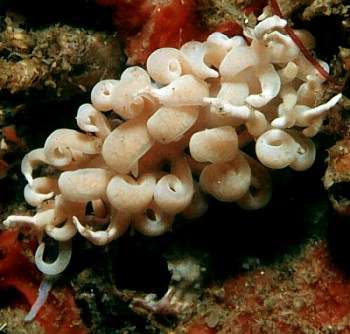
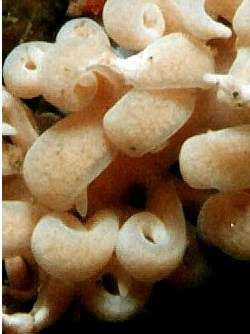
Dear Valda,
I think this is Phyllodesmium hyalinum. You can see through the almost transparent ceratal wall, that branches of the digestive gland radiate out from a central duct. This cuts out P. horridum which has a simple unbranched digestive gland duct. To confirm this identification I would need a specimen, or at least I would need to know where the anus is, which is difficult to see in living animals because of the cerata. If it is P. hyalinum it feeds on Xenia or a close relative, often hiding in a cavity it eats out in the basal 'stalk' or 'trunk' of the soft coral colony.
Concerning colour. I suspect the paler upper animal is paler in colour because it has a sparser network of digestive gland branches. This could be a result of food shortage. Certainly some aeolids I have looked at resorb their body organs, or parts of them when they are starved.
In some species, such as Phyllodesmium serratum, colour depends on the colour of their food, which itself ranges from white to red, orange and pink. On the other hand some species, such as P. hyalinum feed on only one prey and show little variation. In this case from pale watery white to a creamy brown.
Best wishes,
Bill Rudman.
Phyllodesmium identifications
October 16, 1998
From: Bob Bolland
Bill:
I just took a look at the images; thanx so much for posting the information, this solves some problems for me and I'll go through my Phyllodesmium slides later today.
Best regards,
bob
Bob Bolland
OKINAWA
bolland@imicom.or.jp
Bolland, R.F., 1998 (Oct 16) Phyllodesmium identifications. [Message in] Sea Slug Forum. Australian Museum, Sydney. Available from http://www.seaslugforum.net/find/268Phyllodesmium identification query
October 15, 1998
From: Bob Bolland
August 1998
Bill:
Very sorry to bother you with this, as I'm certain that you're more than just a little bit busy.
I thought I had my Okinawan Phyllodesmium spp. figured out but I fear that I'm making a dreadful error in separating P. cryticum and P. hyalinum. I'd really like to see your descriptions of these in:
Rudman, W.B. (1981b) The anatomy and biology of alcyonarian feeding aeolid opisthobranch molluscs and their development of symbiosis with zooxanthellae. Zoological Journal of the Linnean Society 72: 219-262.
I was certain that I had the above paper in my possession but apparently not. If you still have copies or partial copies w/ descriptions/comments of the two Phyllodesmium spp., I'd be forever in your debt.
Best regards,
Bob
Robert F. Bolland
University of Maryland/ASIA
PSC 80, Box 14149, APO AP 96367
OKINAWA
OKINAWA SLUG SITE:
http://www.imicom.or.jp/~bolland/
bolland@imicom.or.jp
Bolland, R.F., 1998 (Oct 15) Phyllodesmium identification query. [Message in] Sea Slug Forum. Australian Museum, Sydney. Available from http://www.seaslugforum.net/find/267dear Bob,
My reply's a bit late but I thought this was a good way to distinguish the two species . I'll send you a photocopy of the paper you request when I get a chance. Otherwise hopefully this will solve your problems. ... Bill Rudman.
